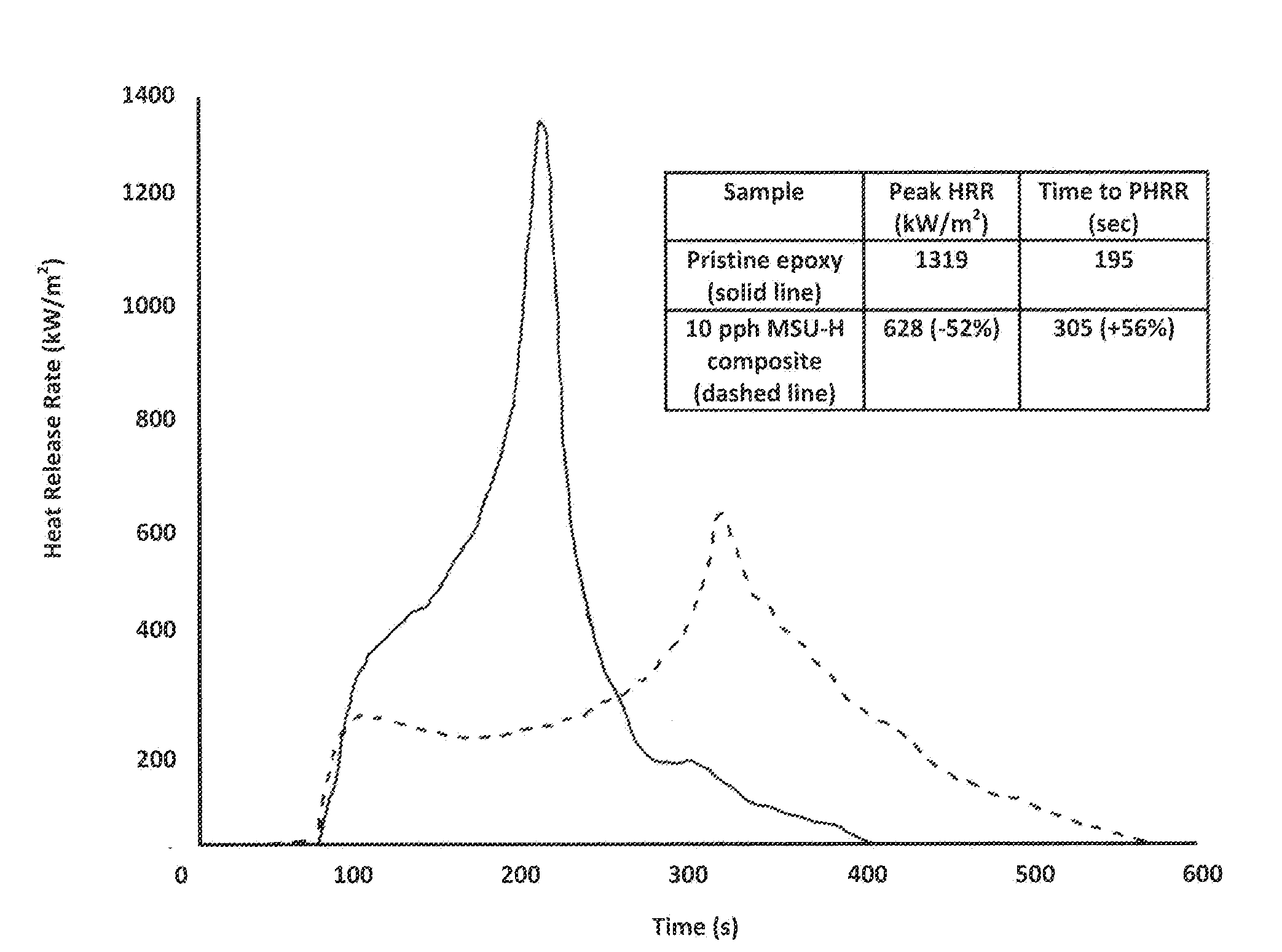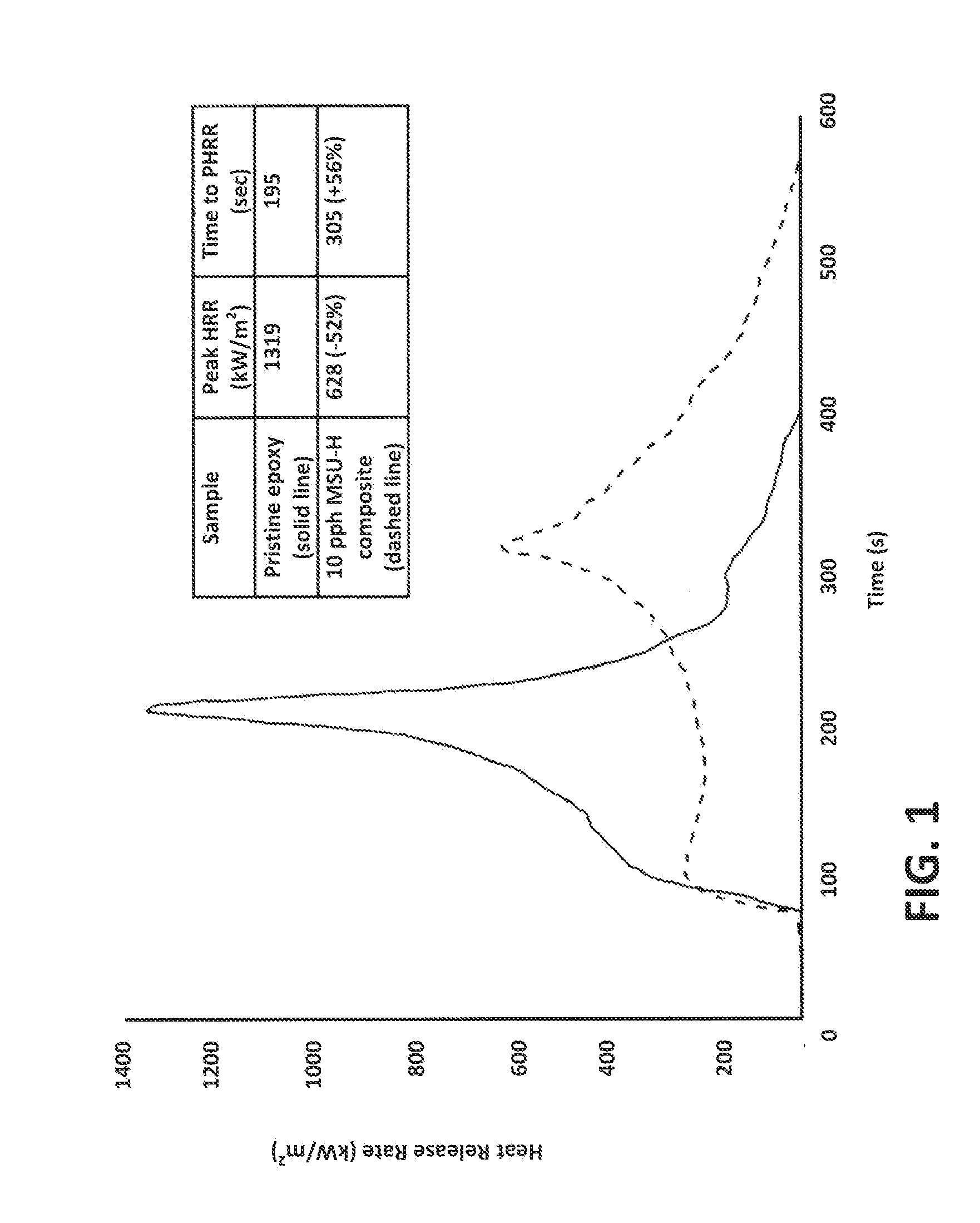Mesoporous Silicate Fire Retardant Compositions
- Summary
- Abstract
- Description
- Claims
- Application Information
AI Technical Summary
Benefits of technology
Problems solved by technology
Method used
Image
Examples
example 1
Epoxy-Mesoporous Silicate Composites
[0053]Cone calorimeter plaques were prepared as follows: a 76-gram quantity of epoxy polymer (Epon 826) was weighed into a plastic beaker. The beaker was placed in a 50° C. sand bath for 20 minutes. At the end of the 20 minutes, 5.0 or 10.0 grams of the desired mesoporous silicate additive was added and stirred—in by hand for 20 minutes. After stirring was completed, the composited polymer mixture was allowed to age in the 50° C. sand bath for one hour. The beaker containing the mixture was removed from the sand bath. Next, 24 grams of curing agent (Jeffamine D-230) were added and incorporated by hand stifling. Once incorporated, the mixture was stirred magnetically for 20 minutes. The mixture was then de-gassed under vacuum. Once de-gassed under vacuum at 50° C., the mixture was placed in silicone molds measuring 100 mm×100 mm×5 mm. The molds were pre-cleaned with ethyl alcohol and pre-treated with release agent (Mono-Coat E179). The specimens we...
example 2
Epoxy-Mesoporous Silicate-Urea Composites
[0067]Cone calorimeter plaques were prepared as follows: a 76-gram quantity of epoxy polymer (Epon 826) was weighed into a plastic beaker. The beaker was placed in a 50° C. sand bath for 20 minutes. At the end of the 20 minutes, mesoporous silicate and urea additives were added and stirred-in by hand for 20 minutes. After stifling was completed, the composite polymer mixture was allowed to age in the 50° C. sand bath for one hour. The beaker containing the mixture was removed from the sand bath. Next, 24 grams of curing agent (Jeffamine D-230) were added and incorporated by hand stifling. Once incorporated, the mixture was stirred magnetically for 20 minutes. The mixture was then de-gassed under vacuum. Once de-gassed under vacuum at 50° C., the mixture was placed in silicone molds measuring 100 mm×100 mm×5 mm. The molds were pre-cleaned with ethyl alcohol and pre-treated with release agent (Mono-Coat E179). The specimens were then cured for ...
example 3
Epoxy-Mesoporous Silicate-Ammonium Polyphosphate Composites
[0073]Cone calorimeter plaques were prepared as follows: a 76-gram quantity of epoxy polymer (Epon 826) was weighed into a plastic beaker. The beaker was placed in a 50° C. sand bath for 20 minutes. At the end of the 20 minutes, mesoporous silicate and Exolit 422 ammonium polyphosphate (Clariant) additives were added and stirred—in by hand for 20 minutes. After stirring was completed, the composited polymer mixture was allowed to age in the 50° C. sand bath for one hour. The beaker containing the mixture was removed from the sand bath. Next, 24 grams of curing agent (Jeffamine D-230) were added and incorporated by hand stirring. Once incorporated, the mixture was stirred magnetically for 20 minutes. The mixture was then de-gassed under vacuum. Once de-gassed under vacuum at 50° C., the mixture was placed in silicone molds measuring 100 mm×100 mm×5 mm. The molds were pre-cleaned with ethyl alcohol and pre-treated with release...
PUM
| Property | Measurement | Unit |
|---|---|---|
| Fraction | aaaaa | aaaaa |
| Percent by mass | aaaaa | aaaaa |
| Fraction | aaaaa | aaaaa |
Abstract
Description
Claims
Application Information
 Login to View More
Login to View More - R&D
- Intellectual Property
- Life Sciences
- Materials
- Tech Scout
- Unparalleled Data Quality
- Higher Quality Content
- 60% Fewer Hallucinations
Browse by: Latest US Patents, China's latest patents, Technical Efficacy Thesaurus, Application Domain, Technology Topic, Popular Technical Reports.
© 2025 PatSnap. All rights reserved.Legal|Privacy policy|Modern Slavery Act Transparency Statement|Sitemap|About US| Contact US: help@patsnap.com


